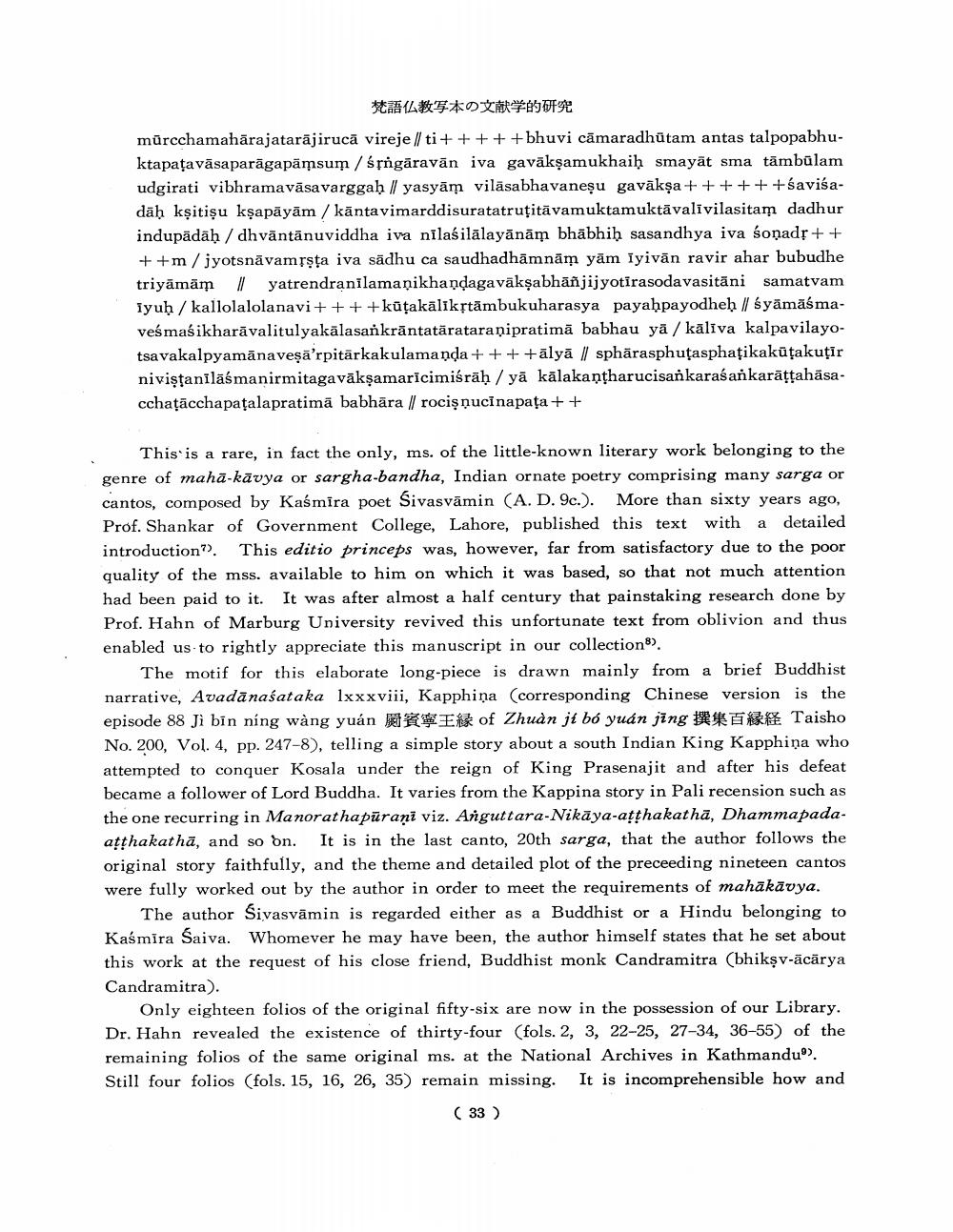________________
梵語仏教写本の文献学的研究
mūrcchamahārajatarājirucā virejeti+ + + + +bhuvi cāmaradhūtam antas talpopabhuktapatavāsaparāgapāmsum / śšngāravān iva gavākşamukhaiḥ smayāt sma tāmbūlam udgirati vibhramavāsavarggah / yasyām vilāsabhavaneşu gavākşa+ + + + + +śavisadāḥ kṣitişu kşapāyām / kāntavimarddisuratatruţitāvamuktamuktāvalivilasitam dadhur indupädah / dhvāntānuviddha iva nīlaśilālayānām bhabhih sasandhya iva sonadr + + + +m/jyotsnāvamțşta iva sädhu ca saudhadhāmnām yām iyivān ravir ahar bubudhe triyāmām l yatrendranilamaņikhandagavākṣabhāñjijyotirasodavasitāni samatvam iyuḥ / kallolalolanavi+ + + + kūțakālīkstāmbukuharasya payahpayodheḥ // śyāmāśmaveśmaśikharāvalitulyakālasankrāntatārataranipratimā babhau yā / kāliva kalpavilayotsavakalpyamānaveşā'rpitärkakulamanda + + + +ālyā || sphärasphuţasphatikakutakutir niviştanilāśmanirmitagavākşamaricimiśrāḥ / yā kālakantharucisankaraśankarāțțahāsacchatäcchapatalapratimā babhāra | rocişnucinapata + +
This is a rare, in fact the only, ms. of the little-known literary work belonging to the genre of maha-kavya or sargha-bandha, Indian ornate poetry comprising many sarga or cantos, composed by Kaśmira poet Sivasvāmin (A. D. 9c.). More than sixty years ago, Prof. Shankar of Government College, Lahore, published this text with a detailed introduction”. This editio princeps was, however, far from satisfactory due to the poor quality of the mss. available to him on which it was based, so that not much attention had been paid to it. It was after almost a half century that painstaking research done by Prof. Hahn of Marburg University revived this unfortunate text from oblivion and thus enabled us to rightly appreciate this manuscript in our collection®).
The motif for this elaborate long-piece is drawn mainly from a brief Buddhist narrative, Avadānaśataka lxxxviii, Kapphiņa (corresponding Chinese version is the episode 88 Ji bin níng wang yuán
of Zhuan ji bó yuan jing
. Taisho No. 200, Vol. 4, pp. 247-8), telling a simple story about a south Indian King Kapphiņa who attempted to conquer Kosala under the reign of King Prasenajit and after his defeat became a follower of Lord Buddha. It varies from the Kappina story in Pali recension such as the one recurring in Manorathapurani viz. Anguttara-Nikāya-aţthakathā, Dhammapadaatthakathā, and so on. It is in the last canto, 20th sarga, that the author follows the original story faithfully, and the theme and detailed plot of the preceeding nineteen cantos were fully worked out by the author in order to meet the requirements of mahākāvya.
The author Sivasvāmin is regarded either as a Buddhist or a Hindu belonging to Kaśmira Saiva. Whomever he may have been, the author himself states that he set about this work at the request of his close friend, Buddhist monk Candramitra (bhikṣv-ācārya Candramitra).
Only eighteen folios of the original fifty-six are now in the possession of our Library. Dr. Hahn revealed the existence of thirty-four (fols. 2, 3, 22-25, 27-34, 36-55) of the remaining folios of the same original ms. at the National Archives in Kathmandu. Still four folios (fols. 15, 16, 26, 35) remain missing. It is incomprehensible how and
( 33 )




